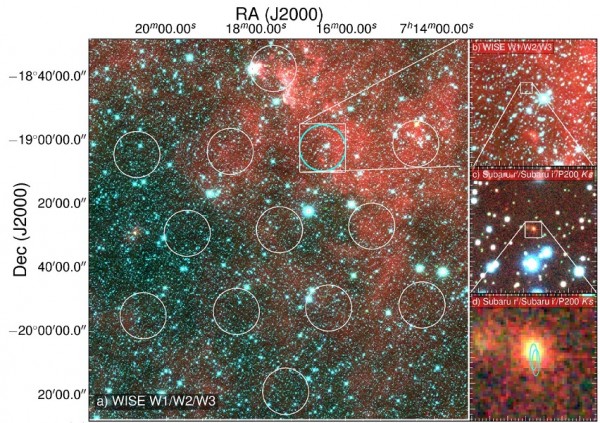By Ana Verayo, | February 26, 2016

This image shows the field of view of the Parkes radio telescope on the left. On the right are successive zoom-ins in on the area where the signal came from (cyan circular region). The image at the bottom right shows the Subaru image of the FRB galaxy, wi
For the first time ever, mysterious radio bursts or signals that have been an enigma to astronomers due to their origin, have now been traced to an exact location, where this signal comes from a distant galaxy some 6 billion light years away.
Like Us on Facebook
These cosmic radio signals that have been travelling across the universe are also known as fast radio bursts, which are powerful flashes of radio waves that are originally from the far reaches of the universe, emitting as much energy as the sun can release in 10,000 years, all in just one millisecond.
The radio bursts were first detected in 2007 as there are only 17 signals that were ever detected, although astronomers believe that these powerful bursts are released 10,000 times in a day that can occur at any time across the skies. However, it is still unknown what causes these powerful jets of energy.
According to astrophysics head and co-author of the study, Simon Johnston of Australia's Commonwealth Scientific and Industrial Research Organization, this incredible discovery can offer new ways how to uncover the true origins of these bursts. In this new study, not only does it confirm the existence of these FRBs but researchers say that it can now allow scientists to search for matter in the universe that are "invisible".
This invisible matter is what astronomers believe as part of a huge percentage of what makes up the entire universe, specifically, 70 percent dark energy and 25 percent dark matter and only 5 percent visible matter, which is what we see today. To date, astronomers have only been able to detect just almost half of the matter in the universe, that are made from stars, galaxies and hydrogen gas.
In this new study, scientists can now use this newly detected burst known as FRB 150418 as a measuring tool to "weigh" how much matter the universe contains, or just measure the visible matter it holds. According to lead author of the study, Evan Keane of the SKA (Square Kilometre Array) Organisation in the U.K., our observations and the model match, which means that this missing or invisible matter has been found.
For the first time ever, a fast radio burst has been utilized as a cosmological measurement. Most FRBs are detected from recorded, consolidated data making this a slow and arduous process, resulting in years of confirmation after the actual event.
Now, the team devised a new system to detect them in seconds after occurring, allowing scientists to notify other telescopes and observatories about its exact location.
This latest FRB discovery was detected last April 2015 with the help of the CSIRO's (Commonwealth Scientific and Industrial Research Organization) Parkes telescope, after this initial detection, two hours later, CSIRO's Compact Array telescope zoomed in on the specific area in the sky where the burst was detected, resulting in a flash of energy. The radio source lasted for six days until fading out its afterglow.
Researchers zoomed in and examined this FRB around 1,000 times more in detail unlike the other bursts. After alerting other telescopes about this FRB, the Subaru telescope in Hawaii matched this FRB with an elliptical galaxy located some 6 billion light years away.
Johnston says that this was unexpected as this FRB may have come from two neutron stars in a collision process rather than a recent star birth.
According to Duncan Lorimer from the West Virginia University who also discovered the first FRB, he expects more bursts to be detected as they can offer a better understanding of their sources such as collapsing neutron stars, evaporating black holes and even non stellar events such as cosmic strings.
This new study is published in the journal, Nature.
-
Use of Coronavirus Pandemic Drones Raises Privacy Concerns: Drones Spread Fear, Local Officials Say

-
Coronavirus Hampers The Delivery Of Lockheed Martin F-35 Stealth Fighters For 2020

-
Instagram Speeds Up Plans to Add Account Memorialization Feature Due to COVID-19 Deaths

-
NASA: Perseverance Plans to Bring 'Mars Rock' to Earth in 2031

-
600 Dead And 3,000 In The Hospital as Iranians Believed Drinking High-Concentrations of Alcohol Can Cure The Coronavirus

-
600 Dead And 3,000 In The Hospital as Iranians Believed Drinking High-Concentrations of Alcohol Can Cure The Coronavirus

-
COVID-19: Doctors, Nurses Use Virtual Reality to Learn New Skills in Treating Coronavirus Patients







